Pacific Southwest, Region 9
Serving: Arizona, California, Hawaii, Nevada, Pacific Islands, Tribal Nations
 Activity in California
Activity in California
On this page:
- City College of San Francisco's Alternative Transportation Technology Imitative
- San Francisco Opens First Biodiesel Fueling Station
- First Biodiesel Plant Opens along California’s Central Coast
- City of Berkeley: A Biodiesel Pioneer
- Port Hueneme Naval Base: Fat to Fuel on the Front Lines
- NASA Buses Run on Biodiesel
- San Joaquin Valley Biodiesel Project: Fields to Fuel
- San Francisco Sets Goals for Diesel-fueled Vehicles
- Santa Cruz: A Community Taking Action
- West Oakland Facility to Produce and Test Biodiesel
City College of San Francisco's Alternative Transportation Technology Initiative
to Promote Study of Biodiesel
On March 9, 2007, EPA awarded a $200,000 grant to City College of San Francisco to develop training programs for biodiesel producers and users. The biodiesel project will be administered as part of City College's Alternative Transportation Technology initiative (ATTi) based at the Evans Campus. CCSF will share the new training curriculum with other ATTi centers throughout the state. San Francisco's Department of the Environment will also be involved and will focus on improving air quality in the Southeast sector of the city.
Ultimately, the project will transform biodiesel from a "boutique" fuel into a mainstream fuel option, making it readily available throughout the Bay Area, and eventually, throughout the West Coast.
"This grant gives City College of San Francisco a unique opportunity to help jump start the use of biodiesel in the Bay Area," said Wayne Nastri the EPA's Administrator for the Pacific Southwest region. "Bringing biodiesel into mainstream use provides a homegrown fuel source that improves air quality and reduces the impact of waste oil to our waterways."
According to ATTi Director Gerald Bernstein, "Biodiesel is not merely a rural issue. The use, emissions and health impacts of petroleum-based diesel exhaust make the need for Biodiesel a serious urban need. This also fits well with the initiatives by the City of San Francisco to promote the use of renewable fuels in municipal fleets."
Nastri joined Dr. Philip R. Day, Jr. City College Chancellor, Phyllis McGuire, Associate Vice Chancellor and Jared Blumenfeld, San Francisco Department of Environmental Services Director on a tour of City College of San Francisco's Alternative Transportation Technology Institute automotive shop where students manufacture and test bio-diesel on engines, trucks and cars.
"CCSF has a long history of developing technical skill training for existing and emerging industries" said CCSF Chancellor Dr. Philip R. Day Jr, "This 'Bridging the Biodiesel Gap' initiative will facilitate the introduction of biodiesel fuel to users throughout the Bay Area. Beyond this training, however, will be emission reductions, improved air quality and improved health here in BayView-Hunters Point and other parts of the City."
This project, part of the larger, West Coast Collaborative, brings in Bay Area biodiesel experts and projects, including: Community Fuels, Peoples' Fuel, BioSolar, and CytoCulture International, Inc. The team also includes the City's environmental justice program, which focuses on the air pollution and energy concerns in Bayview-Hunters Point. City College will establish two distribution services and use biodiesel blends on eight Bay Area fleets. Additionally, City College will share the biodiesel training curriculum with other Alternative Transportation Technology Institutes, state-wide. Though not a distributor, City College uses waste oil to produce and test biodiesel.
For more information, City College's Alternative Transportation Technology Institute ![]()
More information about biodiesel and reducing diesel emissions
West Coast Collaborative ![]()
San Francisco Opens First Biodiesel Fueling Station -
Trucks Running on Waste Oil from City Restaurants

On Tuesday, April 24, the U.S. EPA recognized the city of San Francisco for its biofuels initiative at the City's first biodiesel fueling station in the Bayview-Hunter's Point neighborhood. The station will supply commercially licensed diesel vehicles with "B20" made from converting restaurant waste grease to biodiesel.
Read full story
First Biodiesel Plant Opens along California’s Central Coast
“We want to create a community-based, closed-loop system in which we draw upon local renewable resources such as crops and restaurant oil to produce biofuel for the local community,” said Richard Gillis, President and Chief Executive Officer of EASI.
Energy Alternative Solutions, Inc. or EASI opened a $1.3 million biodiesel production plant — the first along the Central Coast — on Dec. 1st. The 10,000 square foot plant in Gonzales will produce 2.5 million gallons of biodiesel each year. The plant was designed by industry pioneers, Bob and Kelly King of Pacific Biodiesel from Maui, HI.
The biodiesel industry is growing at an explosive rate. Currently, there are only three biodiesel plants in the state of California. EASI plans to open a total of seven plants within a few years, bringing production up to 25 million gallons annually.
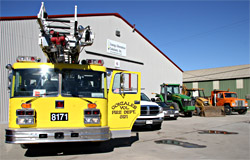
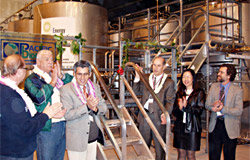
City of Berkeley: A Biodiesel Pioneer
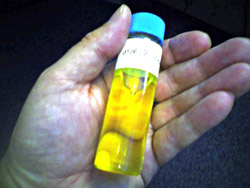
The city of Berkeley has long been a pioneer in environmental issues. Twenty-seven years ago the city was one of the first in the country to introduce curbside recycling. In 2003, Berkeley began paving the way for alternative fuel use by using 100% biodiesel in all city diesel vehicles. Being one of the first cities to use biodiesel, the city experienced minor quality control issues and switched to using a mixture of 20% biodiesel and 80% petroleum-based diesel (B20). The city currently runs 138 diesel vehicles on B20.
Port Hueneme Naval Base: Fat to Fuel on the Front Lines
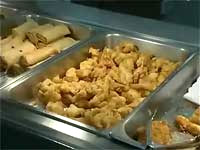
In 2003, the Naval Facilities Engineering Service Center of Port Hueneme in Ventura County, California partnered with Biodiesel Industries, Inc. to convert waste cooking oil generated on-site into biodiesel. The waste grease is collected from six food service facilities located on base and is processed through a 140-gallon per day biodiesel reactor, which is housed in a standard-sized truck container.
The second phase of the agreement, expected to launch in the winter of 2006, aims at replacing the pilot reactor with a portable modular unit with the capability of processing up to 3 million gallons of biodiesel per year. This innovative technology could set the model for other military facilities to follow, with the eventual goal of taking the portable unit on marine vessels overseas to aid in fuel supply.More information:
Search with "Navy biofuels" at rendermagazine.com ![]()
NASA Buses Run on Biodiesel
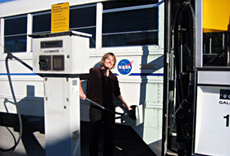
Local city governments and military bases are not the only organizations in California using biodiesel. The National Aeronautics and Space Administration (NASA) also uses this alternative fuel. Over the span of two years, the NASA Ames Research Center located in Moffett Field has purchased over 63,000 gallons of B20 (20% biodiesel plus 80% petroleum-based diesel #2). The fuel is used in diesel-powered equipment such as generators and pumps and all diesel #2 vehicles. No changes to the engines were required for the switch from petroleum diesel to biodiesel.
San Joaquin Valley Biodiesel Project: Fields to Fuel
Sustainable Conservation, an independent non-profit organization, received a $100,000 grant from the EPA via the West Coast Collaborative ![]() to produce biodiesel from locally grown seed crops and test a NOx reduction additive in real world applications on the farm.
to produce biodiesel from locally grown seed crops and test a NOx reduction additive in real world applications on the farm.
More information:
Fact sheet and project announcement (PDF) (3 pages, 120 K)
Santa Cruz: A Community Taking Action
“We hope this community-based project will be a model ultimately replicated across the country.” –Jeff Scott, director of the Waste Management Division, Region 9
Ecology Action, a nonprofit organization based in Santa Cruz, is in the midst of piloting the first community-based biodiesel production program in the United States. This pilot will “harvest the urban crop” – restaurant grease to make biodiesel rather than using virgin oils. Ecology Action has partnered with local restaurants, biodiesel manufacturers and distributors, hauling companies, and the City of Santa Cruz’s Public Works Department to produce and use biodiesel in the City’s fleet. Overall, the project aims to divert 100,000 gallons of waste cooking oil from landfills and benefit the local economy.
In the fall of 2005, EPA awarded Ecology Action a $75,000 Innovation Workgroup (IWG) grant. IWG grants fund creative approaches to waste minimization, energy recovery, recycling, and land revitalization that may be replicated across industries, communities, and regions.
More information:
EPA Press Release about the Santa Cruz project
San Francisco Sets Goals for Diesel-fueled Vehicles
San Francisco Mayor Gavin Newsom issued an executive directive to accelerate the rate of city-wide biodiesel use in May of 2006. The directive urges city and county departments with diesel fuel needs to begin using biodiesel as soon as possible. The mayor set an overall goal of 25% B20 use (20% biodiesel, 80% diesel) by March 2007, and 100% B20 use by the end of 2007. San Francisco has long been committed to improving air quality with its City’s Healthy Air and Smog Prevention ordinance of 1999, which instituted requirements for city fleets to purchase alternative fuel or low emissions vehicles.
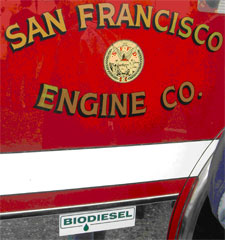
The city presently uses over 8 million gallons of diesel a year. The switch to B20 translates to a 2 million gallon biodiesel demand that ultimately means cleaner air and less energy dependence for the city.
City agencies currently using biodiesel include the Department of Public Works, MUNI buses, and the San Francisco Airport and Zoo, however; leading the way is the San Francisco Fire Department. The department is embarking upon a six month pilot project to incorporate B20 into two fire trucks, one ambulance and six engines. If the pilot project proves to be successful, the fire department has plans to expand the program to other vehicles.
With over 800 alternative fuel vehicles in the City’s fleet and plans to further increase biodiesel use, San Francisco will become the largest U.S. city to implement such a widespread biodiesel initiative.
More information:
Environmental and Energy Study Institute ![]()
West Oakland Facility to Produce and Test Biodiesel
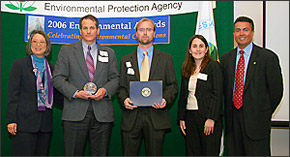
The East Bay Municipal Utility District (EBMUD) is currently working on a pilot biodiesel production project. Fat, oil, and grease (FOG) accumulates in the pipes and pumps of all public sewer systems. This FOG will be collected from the main wastewater treatment plant and used to produce high quality biodiesel meeting American Standard for Testing Material (ASTM) standards.
The biodiesel will power two EBMUD vehicles. The vehicles’ performance and emissions will be compared to vehicles operated using California Air Resources Board (CARB) approved low sulfur diesel. During the year-long pilot, emission reductions are estimated to be 800 lbs. of hydrocarbon, 35 lbs. of particulate matter, and 30 lbs. of carbon monoxide.
If the project proves to be a success, it is likely that the pilot will lay the foundation for large-scale production of biodiesel to meet the entire EBMUD diesel demand. Increased biodiesel use could prove to be environmentally beneficial for the East Bay service area. The project is expected to be completed by March 2008.
